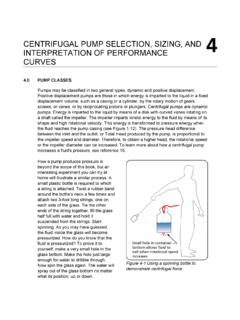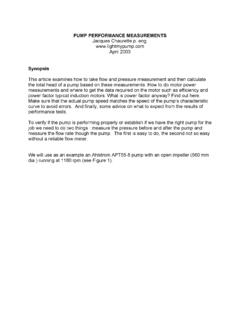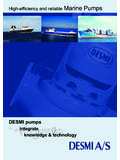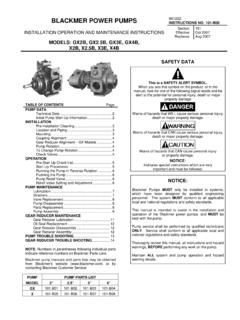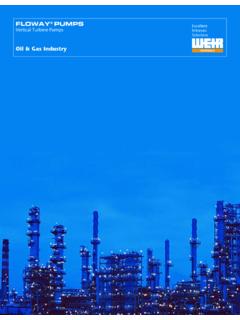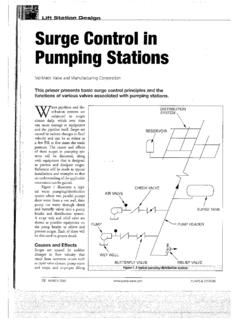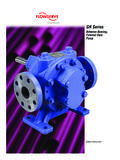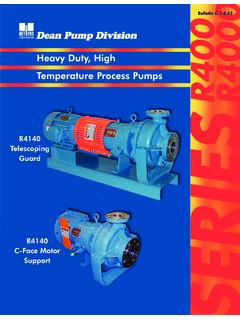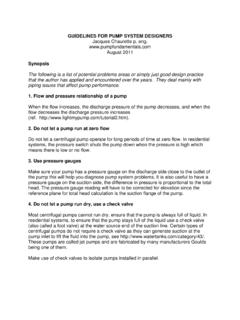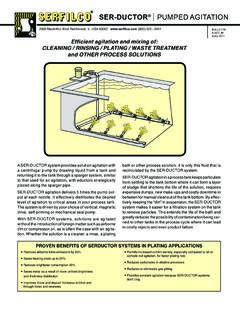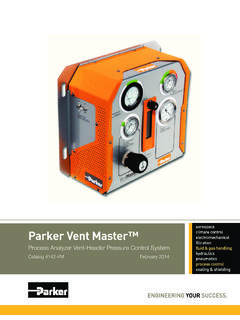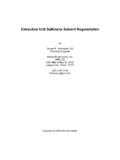Transcription of Slurry Pumping Handbook - AU - …
1 Issued: Feb 2000. WARMAN INTERNATIONAL LTD. WARMAN. Slurry Pumping . Handbook . Australasian Version: Feb 2000. Warman International Ltd. is the owner of the Copyright subsisting in this Manual. The Manual may not be reproduced or copied in whole or in part in any form or by any means without the prior consent in writing of Warman International Ltd. Slurry Pumping Handbook AU Page 2 Issued: Feb 2000. WARNINGS. IMPORTANT SAFETY INFORMATION.. The WARMAN PUMP is both a PRESSURE VESSEL and a piece of ROTATING. EQUIPMENT. All standard safety precautions for such equipment should be followed before and during installation, operation and maintenance.. For AUXILIARY EQUIPMENT (motors, belt drives, couplings, gear reducers, variable speed drives, etc.) standard safety precautions should be followed and appropriate instruction manuals consulted before and during installation, operation, adjustment and maintenance.
2 All guards for rotating parts must be correctly fitted before operating the pump including guards removed temporarily for gland inspection and adjustment.. DRIVER ROTATION MUST BE CHECKED before belts or couplings are connected. Personnel injury and damage could result from operating the pump in the wrong direction.. DO NOT OPERATE THE PUMP AT LOW OR ZERO FLOW CONDITIONS FOR. PROLONGED PERIODS, OR UNDER ANY CIRCUMSTANCES THAT COULD. CAUSE THE Pumping LIQUID TO VAPORISE. Personnel injury and equipment damage could result from the pressure created.. DO NOT APPLY HEAT TO IMPELLER BOSS OR NOSE in an effort to loosen the impeller thread prior to impeller removal. Personnel injury and equipment damage could result from the impeller shattering or exploding when the heat is applied.. DO NOT FEED VERY HOT OR VERY COLD LIQUID into a pump which is at ambient temperature.
3 Thermal shock may cause the pump casing to crack.. FOR THE SAFETY OF OPERATING PERSONNEL, please note that the information supplied in this Manual only applies to the fitting of genuine Warman parts and Warman recommended bearings to Warman pumps.. LIFTING PUMP COMPONENTS. Tapped Holes (for Eye Bolts) and Lugs (for Shackles) on Warman Parts are for lifting Individual Parts Only. Lifting devices of adequate capacity must be used in conjunction with these assembly and maintenance instructions wherever they are required to be used. Sound, safe workshop practices should be applied during all assembly and maintenance work. Personnel should never work under suspended loads.. FULLY ISOLATE THE PUMP before any maintenance, inspection or troubleshooting involving work on sections which are potentially pressurised (eg casing, gland, connected pipework) or involving work on the mechanical drive system (eg shaft, bearing assembly, coupling):- Power to the electric motor must be isolated and tagged out.
4 It must be proven that the intake and discharge openings are totally isolated from all potentially pressurised connections and that they are and can only be exposed to atmospheric pressure. Slurry Pumping Handbook AU Page 3 Issued: Feb 2000. CONTENTS. WARNINGS ..2. CONTENTS ..3. SECTION 1: INTRODUCTION ..5. Purpose of this Handbook ..5. Definition of a Characteristics of a Slurry ..5. What is a Slurry Pump ..5. Components of a Slurry Pump ..6. Range of Applications of a Slurry Pump ..8. Concepts of Material SECTION 2: DEFINING YOUR APPLICATION & CONSTRAINTS .. 11. Properties of a Slurry .. 11. Volume/Flow 15. Pipeline Length .. 15. Static Head Required .. 15. Pipe 15. Pump Performance 16. System Resistance Curves .. 18. Other Design Constraints .. 20. SECTION 3: SELECTING THE APPROPRIATE PUMP .. 27.
5 Determine the Flow 27. Determine the Static Head .. 27. Determine the Pump Head & Efficiency Corrections .. 27. Determine the Pipe Diameter .. 27. Calculate the Friction Head 27. Calculate the Total Dynamic Head .. 28. Select Pump Type & Materials .. 28. Pump 28. Determine the Pump Speed .. 29. Calculate the Required 29. Additional Design 29. Typical Pump 32. APPENDIX 1 PUMP TYPES .. 37. Introduction .. 37. Horizontal Pumps - Lined .. 37. Horizontal Pumps - 40. Slurry Pumping Handbook AU Page 4 Issued: Feb 2000. Vertical Pumps .. 44. Jet Pumps .. 47. APPENDIX 2 MATERIALS .. 48. Introduction .. 48. APPENDIX 3 Slurry FRICTION HEAD LOSSES IN 57. Introduction .. 57. Homogeneous Slurries: (Particles Essentially all Finer than 50 m) .. 57. Heterogeneous Slurries: Category A' .. 57. Heterogeneous Slurries: Category B'.
6 59. Heterogeneous Slurries: Category C' .. 60. Heterogeneous Slurries: Category D' .. 60. Estimation of Friction Head Losses for Clear Water .. 60. APPENDIX 4 TOTAL DYNAMIC 64. 64. Relationships between Head, Specific Gravity and Pressure or Vacuum .. 65. Total Dynamic 65. Estimation of Total Dynamic Head .. 67. Separate Estimates of Suction Head & Discharge Head .. 67. APPENDIX 5 LIMITING SETTLING VELOCITY .. 71. General Notes .. 71. Determination of Limiting Settling 71. Effect of Pipe Diameter on Limiting Velocity .. 73. APPENDIX 6 NET POSITIVE SUCTION HEAD (NPSH).. 74. General Notes .. 74. Formulae for NPSHa .. 75. APPENDIX 7 SERIES Pumping .. 79. General Notes .. 79. Single 79. Two-Stage Pump Unit .. 80. Four-Stage Pump 80. 82. Slurry Pumping Handbook AU Page 5 Issued: Feb 2000. Section 1: INTRODUCTION.
7 PURPOSE OF THIS Handbook . This Handbook has been compiled to enable you to better evaluate your Slurry Pumping requirements, and to provide guidelines for selecting the correct Slurry pump for your application. DEFINITION OF A Slurry . A Slurry can be a mixture of virtually any liquid combined with some solid particles. The combination of the type, size, shape and quantity of the particles together with the nature of transporting liquid determine the exact characteristics and flow properties of the Slurry . CHARACTERISTICS OF A Slurry . Slurries can be broadly divided into the two general groups of non-settling or settling types. Non-settling slurries entail very fine particles which can form stable homogeneous mixtures exhibiting increased apparent viscosity. These slurries usually have low wearing properties but require very careful consideration when selecting the correct pump and drive, because they often do not behave in the manner of a normal liquid.
8 When fine solids are present in the Slurry in sufficient quantity to cause this change in behaviour away from a normal liquid, they are referred to as being non- Newtonian. Settling slurries are formed by coarser particles and tend to form an unstable mixture and therefore particular attention must be given to flow and power calculations. These coarser particles tend to have higher wearing properties and form the majority of Slurry applications. This type of Slurry is also referred to as being heterogeneous. WHAT IS A Slurry PUMP. There are a large number of differing pump types used in the Pumping of slurries. Positive displacement and special effect types such as Venturi eductors are used but by far the most common type of Slurry pump is the centrifugal pump. The centrifugal Slurry pump utilises the centrifugal force generated by a rotating impeller to impart energy to the Slurry in the same manner as clear liquid type centrifugal pumps.
9 However, this is where the similarities end. Centrifugal Slurry pumps need to consider impeller size and design, its ease of maintenance, the type of shaft seal to be used and the choice of the optimum materials. This is needed to withstand wear caused by the abrasive, erosive and often corrosive attack on the materials. Many other important considerations are also required. Slurry Pumping Handbook AU Page 6 Issued: Feb 2000. The centrifugal Slurry pump must be designed to allow the passage of abrasive particles which can at time be extremely large. The largest Warman Slurry pump, for example, can pump particles up to 530mm in spherical size. Slurry pumps therefore need much wider and heavier impellers to accommodate the passage of large particles. They must also be constructed in special materials to withstand the internal wear caused by the solids.
10 Refer to APPENDIX 2 MATERIALS for further details on these special materials. To achieve lower operating speeds, Slurry pumps are also generally larger in size than a comparable clear liquid pump in order to minimise wear within the pump. Bearings and shafts also need to be much more robust and rigid. Refer APPENDIX 1 PUMP. TYPES to for further details of the various Warman pump types. COMPONENTS OF A Slurry PUMP. IMPELLERS. The impeller is the main rotating component which normally has vanes to impart the centrifugal force to the liquid. Usually, Slurry pump impellers have a plain or a Francis type vane (see Figure 1-1). FIGURE 1-1 IMPELLER VANE PROFILES. The plain vane has a leading edge square to the back shroud, whereas the Francis vane has a leading edge projecting into the impeller eye. Some advantage of the Francis vane profile are the higher efficiency, improved suction performance and slightly better wear life in certain types of Slurry because the incidence angle to the fluid is more effective.
